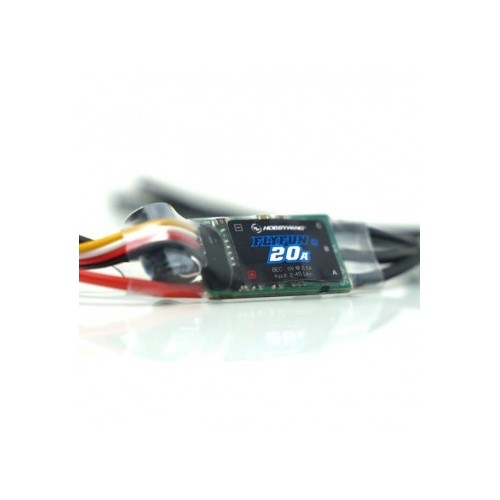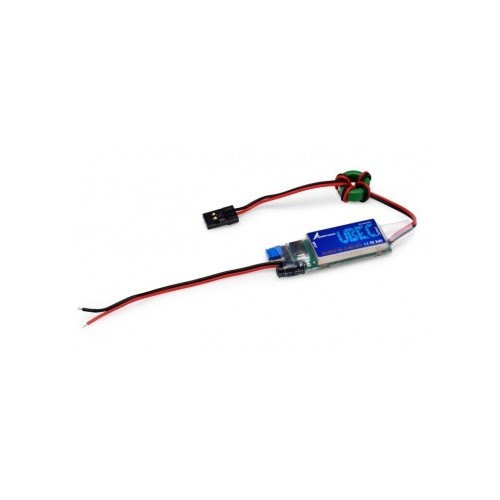UBEC 3A 2-6S
Hobbywing UBEC 3A 2-6S
Why do you need UBEC?The UBEC is a switch-mode DC regulator separated from ESC (ESC---Electronic Speed Controller for brushless/brushed motor), it will take high-voltage (5.5 to 26V) power from your battery pack and convert it to a consistent safe voltage for your receiver, gyro and servos.For traditional speed controller with a built-in BEC, it will very likely have only a limited ability to supply power to your receiver and servos without overheating. If you are using a high-voltage battery pack or have heavy servo load, you should consult the ESC specifications to determine what the stated recommendations or limitations are. In general, if you are using a 4 cells lithium battery pack, or more than a 12 cells Nickel based battery pack, you should consider using an UBEC because in such a case the built-in BEC of the ESC can support only 2 servos, which means it is not suitable for RC helicopter and big aircraft.Specifications:
Output: 5V/3A and 6V/3A Switchable
Ripple: <50mVp-p (@2A/12V)
Input: 5.5-26V (2 to 6 cells LiPo battery pack, 5 to 18 cells NiMH battery pack)
Size: L51x W16.6 x H8.5 mm
Weight: 11.5 g
Features:The UBEC is an advanced switching regulator with over-current and over-heat protection function, and the maximum efficiency of the system is nearly 90%.The small size and the light weight make it very convenient to use.The comparison of linear BEC and switch-mode BEC: When using a lithium battery pack more than 3S, a switch-mode BEC has much higher efficiency than linear BEC.
For a traditional linear BEC, for example, a 4S lithium battery pack has a typical voltage of 14.8V, in order to let BEC output 5V/1A, the current flow into the BEC is at least 1A, so the power on BEC is 14.8V* 1A=14.8W. But the useful output power is only 5V*1A=5W, so the efficiency of the linear mode BEC is just 5W/14.8W=33.8%, the redundant power 14.8W-5W=9.8W changes to the heat, which makes the BEC very hot.
For a switch-mode BEC in the above case, in order to let BEC output 5V/1A, the current flow into BEC is only 0.38A (actual test data), so the power on BEC is 14.8V*0.38A=5.6W, and the efficiency of BEC is 5W/5.6W=89.3%
Don't worry about the polarity of the battery pack. If the polarity is not correct, the UBEC can't work, but it will not be destroyed. What you need to do is just swap the battery pack polarity.A shield covers almost all the electric components on PCB, and a ferrite ring is attached with the output wires a decrease the electromagnetic interference.How to use the UBEC?Important hint:Switch mode UBEC may cause some electromagnetic interference to receiver, Please install the UBEC with a distance at least 5cm away from the receiver.When ESChas notbuilt-in BEC:No change is needed for the ESC, just connect the input cables of UBEC with the battery, and plug the output cable (connector) of the UBEC into one spare channel of the receiver.When ESChasbuilt-in BECYou must disable the built-in BEC of the ESC, that is, you need to cut the red wire in the trio of Rx (receiver) wires. Simply use a pair of wire cutters to remove a short section of the red wire near the receiver connector, and insulate the cut wire a bit of electrical tape.Suggestion: You can use a sharp screwdriver to take the pin (the red wire) out from the BEC connector of the ESC, and then insulate it with a bit of electrical tape for further use, so you don't need to cut the red wire by this method.

















